Soaker hoses and sprinklers are both popular watering systems in lawn maintenance, but each method has its advantages and disadvantages. Sprinkler systems offer a large degree of control for watering your lawn but result in a lot of lost water. Soaker hoses are more water-efficient but can have operational quirks.
Soaker hoses provide more water efficiency than automated sprinkler systems (up to 80%), are less expensive and result in less water lost to evaporation and wind. Water that is applied directly to the root systems of the lawn through a soaker system is better for the plants than soaking the foliage.
Everyone has a slightly different lawn, so whether a soaker hose or a sprinkler is better for your setup depends on a variety of factors. Read on to learn more about soaker hoses and sprinkler systems and the benefits each system can provide in your lawn maintenance.
How a Soaker Hose Works
A soaker hose works through a series of perforated holes along the length of the hose. Once the hose is hooked up to a regular water faucet and turned on, water trickles slowly from these perforations in the hose and drips into the soil, soaking it through right at the roots of the grass.
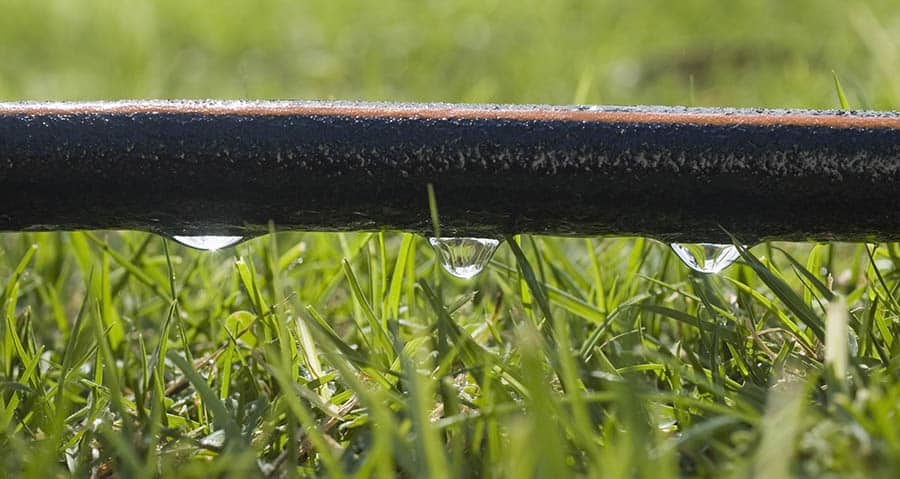
Soaker hoses come in several different lengths so you can choose different sizes depending on the length of your yard and how much area you need to cover.
The four standard sizes of soaker hoses are:
- 25 feet
- 50 feet
- 75 feet
- 100 feet
You will want to get the largest soaker hose that will effectively cover your lawn or garden since having to periodically move the soaker hose around to cover the yard can become tedious. Soaker hoses tend to come in two different types—rounded and flat.
Both types of soaker hose work well to water a lawn, but the rounded soaker hoses tend to outlive the flat ones due to uneven water pressure caused by the hose design.
Soaker hoses are typically run for thirty minutes to water the lawn twice a week. The efficiency of a soaker hose system can be increased by adding a timer to it since this removes the need for the gardener to remember to turn the soaker hose off when the watering is done. This can be a major advantage for forgetful gardeners who tend to leave their water running accidentally. Not only can this damage the grass, but it costs a lot of money in wasted water, too.
How a Sprinkler System Works
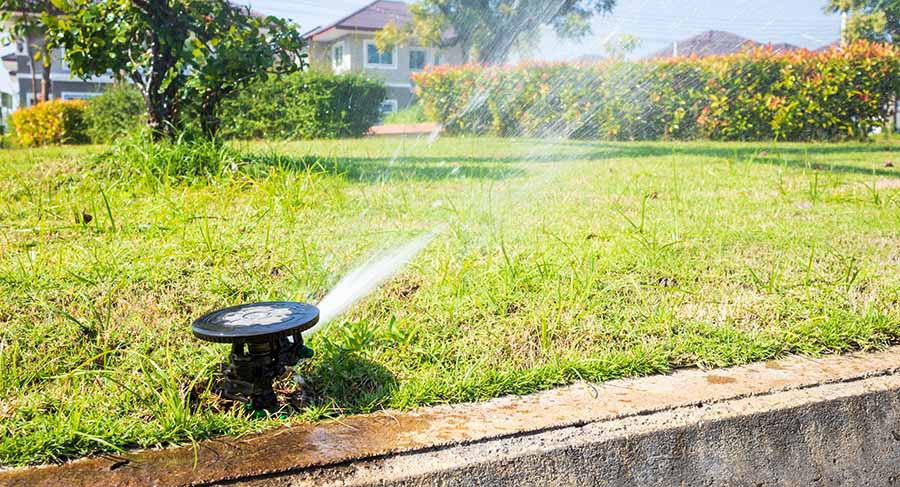
Sprinkler systems can work in a few different ways:
- Some sprinkler systems are portable accessories that are placed on the end of a normal gardening hose and moved around the yard or garden.
- Other sprinkler systems are installed in the lawn itself and are set up on an automated system.
Sprinklers work by spraying water upwards in a fan pattern to disperse water over the surface of the lawn. Some sprinklers are designed to revolve or spray in a back-and-forth overhead motion, but all sprinklers operate by spraying the water up into the air and letting it fall back down over the lawn rather than delivering it to the lawn directly.
Portable sprinklers are much less expensive than sprinkler systems that are installed in the lawn since irrigation systems usually involve laying pipe and other extensive landscaping work. Normally, automated irrigation systems are installed in a lawn before new sod is laid.
Sprinkler systems can be operated manually through the use of a faucet control, or they can be set to a timer. The major advantage of putting a timer on your sprinkler system is that, with a sprinkler, leaving the water on accidentally can result in hundreds of gallons of lost water. Not only will this cause your utility bill to skyrocket, but it can also potentially flood your lawn if you forget the sprinkler on for a long enough period.
Advantages of a Soaker Hose
When it comes to choosing a soaker hose or a sprinkler system for your lawn, there are many advantages that a soaker hose has over a sprinkler system when it comes to efficiency and cost.
Here are some of the benefits of using a soaker hose:
- Deliver water directly to the root systems of grass and trees: Because a soaker hose deposits water directly into the soil, the water is absorbed faster and can penetrate deeper into the earth to encourage plant root systems to extend deeper rather than crawl across the surface of the ground. This can help prevent issues such as busted sidewalks and surface roots in tree systems.
- No loss of water to evaporation or wind: Soaker hoses deliver water to the soil, without losing any to wind or evaporation off the grass and tree foliage. This means that soaker hoses are more environmentally friendly since they waste much less water to accomplish the same watering job as a sprinkler system.
- No excess water on foliage: Water left to stagnate on foliage is a contributing factor to plant diseases, and sprinkler systems can cause water to splash dirt up onto plant leaves, which can cause outbreaks of bacterial or fungal infections.
- Economical: In many cases, soaker hoses are not that much more expensive than a traditional garden hose, and they can be operated with nothing more than a regular faucet system.
- Cheaper water bills: Soaker hoses and drip irrigation systems use significantly less water than sprinkler systems, and over time, this can save hundreds of dollars on your water bill. These savings are only increased the larger your lawn and the area you need to keep watered is.

Soaker hoses can not only save you money when it comes to keeping your lawn maintained, but they can potentially help you keep it healthier-looking, too.
Disadvantages of a Soaker Hose
Even though there are lots of reasons you should try out a soaker hose to keep your lawn watered, there are also some drawbacks to using this kind of watering system.
Here are some of the downsides you should look out for when it comes to operating a soaker hose:
- Connecting multiple soaker hoses results in a loss of water pressure: With soaker hoses, it’s possible to link several hoses together to increase the amount of area they can cover. But it comes with a catch—the further the hoses get away from the water source, the more water pressure is lost.
- Having to move hoses around can be a hassle: If you don’t get a long enough soaker hose to cover your entire yard area, you’ll end up having to go out and rotate it or move it around to get coverage over the yard. Saturated hoses can be both heavy and unwieldy, which makes this a tedious task if you are forced to do it.
- Does not cover as well: A soaker hose may be able to soak the ground more deeply, but it doesn’t cover as wide of an area as a sprinkler system does. This means that you’ll likely have to buy more hose to cover the same area than you would with a sprinkler system.
- Easy to accidentally hit hoses with the lawnmower: If you’re in the habit of leaving your soaker hose out in the yard, you might end up accidentally running it over with the lawnmower. This can be a startling and costly mistake to fix.
Soaker hoses may have many advantages over sprinkler systems, but they are not perfect.
Advantages of a Sprinkler System
While sprinkler systems have a reputation of being less water-efficient than soaker hoses, there are some advantages to using a sprinkler system over an irrigation hose system.
Here are some of the benefits of using a sprinkler system:
- Can cover a large area at once: Sprinkler systems can wet a large area of the yard at once, and if you get a sprinkler head that rotates or goes back and forth across the yard, you can cover most of it without having to move the sprinkler around too much.
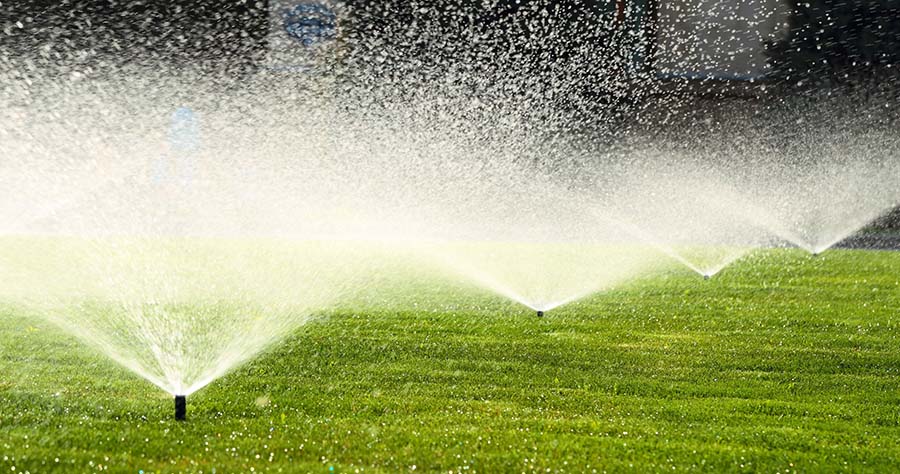
- Can be added as a home amenity: If you get a sprinkler system installed in your lawn rather than a portable sprinkler system, these expensive systems can be counted towards your home equity as an attractive addition to your landscaping. Putting in an automated irrigation sprinkler can add to the property value of your house.
Sprinkler systems aren’t right for every yard, but if you have the money to put in a permanent sprinkler system, it can be worth the trouble to install one.
Disadvantages of a Sprinkler System
Even though there are some advantages to using a sprinkler system, there are some drawbacks to using sprinklers, too.
Here are some of the reasons you might want to reconsider using a sprinkler system:
- Increases ambient humidity: This is especially true if your sprinklers are wetting asphalt as well as soil since the water will steam off of the asphalt. In naturally humid climates, the added humidity created by sprinkler systems can cause the atmosphere in the yard to become unbearably hot and thick.
- Increases chance of disease: Because sprinkler systems tend to splash a lot of water up out of the soil, this can increase the chance of soil-borne pathogens being exposed to the foliage in the grass and trees. This, in turn, can increase the chance of fungal wilts, and other types of soil-borne diseases will attack the plants in your yard.
- Can cause flooding without a timer: A major problem with sprinkler systems is that if they’re not shut off correctly, they can release a lot of water onto the lawn. Too much water can kill the grass or cause a giant mud hole.
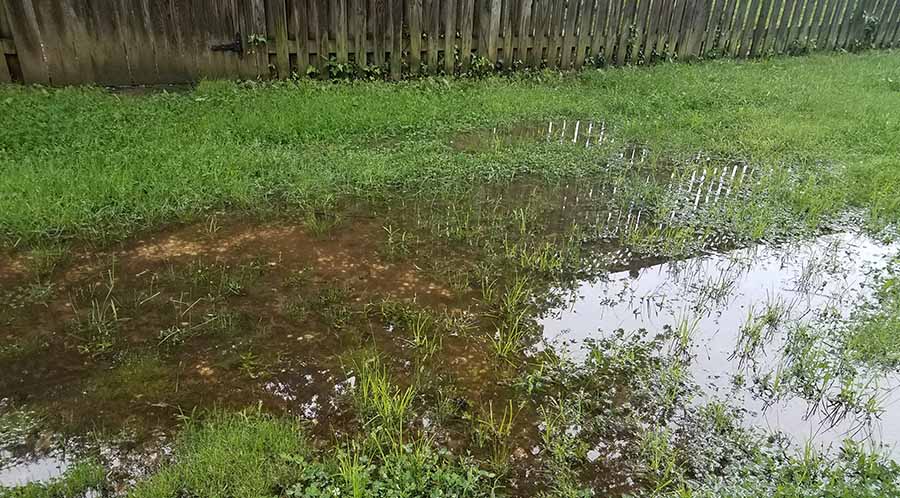
- Only wets the surface: While sprinkler systems are capable of covering a large amount of surface area, they can’t penetrate much deeper than that. Most of the water that is sprayed by a sprinkler system will end up evaporating off the lawn before it has a chance to soak into the soil.
- Automated in-ground sprinkler systems are costly. If you get an automated sprinkler system, these systems can cost hundreds or even thousands of dollars to have installed. This can be cost-prohibitive for many homeowners.
- Running over an in-ground sprinkler system with a lawnmower can be catastrophic. While running over a soaker hose with the lawnmower is an annoying and costly mistake, it isn’t as costly as having to replace the sprinkler head on an in-ground sprinkler system after you run over it with a lawnmower blade.
There are a few reasons why you might want to get a sprinkler, but there are many more why a sprinkler system isn’t always the best bet for watering a lawn.
Why Soaker Hoses Are Better for Your Lawn
If you look at the advantages and disadvantages of soaker hoses versus sprinkler systems, there are a lot more advantages to using soaker hoses. But the number one reason why soaker hoses are a better choice for your lawn is water efficiency.
Soaker hoses use up to 80% less water than a sprinkler system. For large yards, this can mean that you will end up losing a lot more water than you get into your yard. Not only does this mean hundreds of dollars wasted each year in utilities, but it is also a strain on the environment in areas where there are water rationing and water shortages.
Not only do soaker hoses use a lot less water than sprinkler systems do, but they also water the lawn more effectively. By not wasting a bunch of water by spraying it up into the air, soaker hoses provide better watering action to the grass and encourage vertical root growth.
How Much Water Does a Soaker Hose Use in an Hour Versus a Sprinkler?
A soaker hose is a very efficient form of watering for your yard. Over an hour, a soaker hose only uses thirty gallons of water. Compare this to a traditional sprinkler system, which can use a staggering 1,020 gallons of water in the same amount of time.
What is the Best Kind of Sprinkler to Water a Lawn?
If you decide to go with a sprinkler system to water your lawn instead of a soaker hose, you should consider going with a rotating sprinkler. These sprinklers can cover much more ground than a stationary sprinkler, so you’re able to water the lawn more evenly.
Here are some of the different types of sprinkler systems that you can purchase to water your lawn:
- Stationary sprinklers: Stationary sprinklers stay in one area and only spray water over a fixed amount of yard. Stationary sprinklers are best for reaching areas of the yard that are hard to reach for watering, and their small size makes them perfect for use in gardens and flowerbeds.
- In-ground sprinklers: In-ground sprinkler systems are sprinkler systems that run underneath the lawn and have sprinkler heads that come up through the sod. In-ground automated sprinkler systems can be a great way to cut back on maintenance for larger yards, but these systems are costly to install.
- Impact sprinklers: Impact sprinklers—also known as rain bird sprinklers—are a spring-loaded sprinkler type that water very effectively but can also be off-putting because of the amount of noise they make in comparison to other sprinklers.
- Oscillating sprinklers: Oscillating sprinklers are sprinklers that spray water in a back-and-forth motion across the length of the yard. Oscillating sprinklers are one of the most common and cheapest types of sprinklers, but they’re also not as durable as some other sprinkler types.
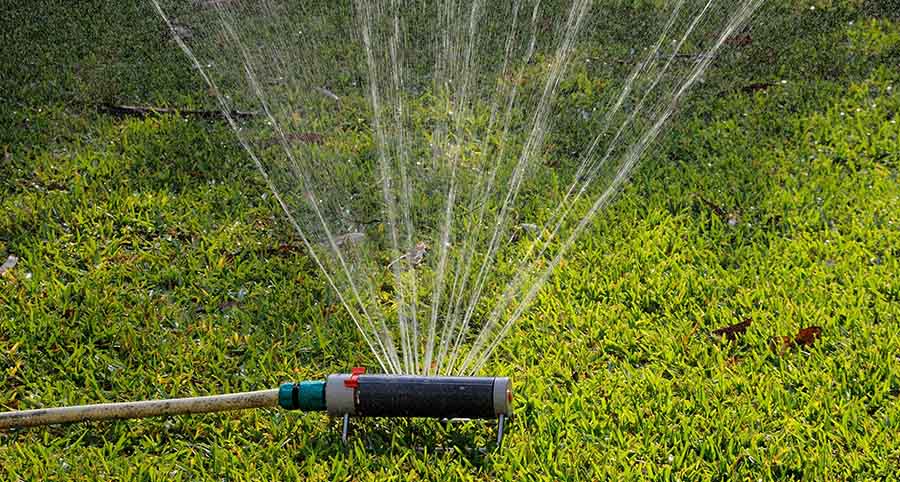
- Sprinkler hoses: Similar to soaker hoses, sprinkler hoses are designed to spray water up in a line along where it is laid. Sprinkler hoses are best used for long strips of a yard or long flowerbeds because of their shape.
- Rotating sprinklers: Rotary sprinklers are popular sprinkler systems for lawns since they can disperse water widely over a large area. Rotating sprinklers are suitable for lawns with heavy or impacted soil since they disperse water more slowly over a longer period than some other sprinkler types.
- Traveling sprinklers: Traveling sprinklers are sprinklers that are designed like miniature tractors and will travel along the yard in a predetermined pathway to water the entire area. Traveling sprinklers are a good sprinkler option for uneven terrain or yards with an odd shape.
There are plenty of different sprinklers to choose from, so if you’d prefer to use a sprinkler system over a soaker hose system, you should be able to find one that suits your needs and the needs of your yard.
Some landscapes may require multiple types of sprinklers depending on what type of lawn you’re trying to water. A person with a large yard may have an in-ground sprinkler system for their lawn, but a separate oscillating system for their vegetable garden. It all depends on what type of soil you have and how much ground you need to cover.
Best Soaker Hoses for Watering Your Lawn
If you decide to go with soaker hoses instead of a sprinkler system, you must get soaker hoses that are made of high-quality materials. Otherwise, you will find yourself replacing them sooner than you’d like.
Here are some of the best soaker hoses you can find on the market, all conveniently available on Amazon:
- One-Stop Gardens 50-Foot Soaker Hose
- Gilmour 75-Foot Flat Soaker Hose
- Rocky Mountain Goods Soaker Hose
- Rain Drip 50-Foot Soaker Hose
- Buyookay 50-Foot Soaker Hose
Inferior soaker hoses can leak or lose water pressure quickly, so if you’re going to go with a soaker hose system for watering your lawn, you want to choose the highest quality soaker hose you can find. The better the hose, the longer it’ll be before you are forced to replace it.
Tips for Watering Your Lawn with a Soaker Hose or Sprinkler System
Whether you use a sprinkler or a soaker hose to water your lawn, following a couple of guidelines about lawn watering can help to prevent you from running into problems. Follow these tips to get the most out of your lawn watering system:
- Water your lawn more when it is hot and sunny. It may sound like common sense, but your lawn’s grass is much more vulnerable to drying out during days with high temperatures and low humidity. If you normally water your lawn twice a week, you may want to increase that amount to three times a week in hot weather.
- Watering early in the morning is better. Not only does this allow the water the penetrate more deeply into the soil before the sun has a chance to evaporate it away, but it also gives the lawn plenty of time to dry before dark. Damp grass breeds pests like mosquitoes and can lead to disease in the grass.
- Install a timer. You can get an automated timer installed on either a soaker hose or sprinkler system, and these timers are extremely useful for making sure that you don’t accidentally leave the water running. This can be both damaging to the yard and also a shot to the water bill, too, if you accidentally leave the water on, especially if it gets left on overnight or for several days.
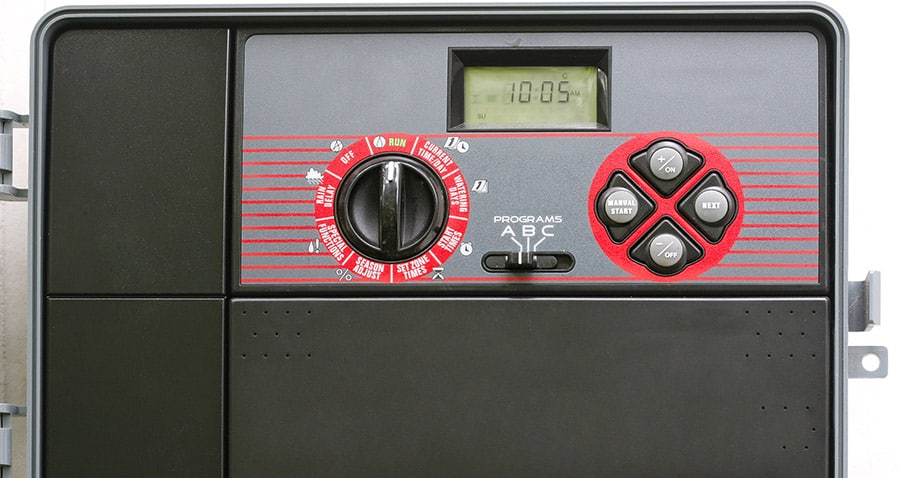
- Intermittent watering is better than saturating your yard. If you space out your lawn watering over a few shorter sessions throughout the day, this allows the water to penetrate more gradually and deeply into the soil. This can help reduce some of the surface penetration issues that usually come with a sprinkler watering system.
- Check the color of the grass. Yellowing grass is usually a sign that the grass is not receiving as much water as it should. If you have any areas of the yard that have patches of yellow, this is usually an indicator of animal urine or disease.
- Don’t water every day. Two to three times a day is plenty for most yards and most climates. Too much water on the lawn will cause it to become soft and will lead to grass death, eventually turning the yard into a mud hole. Also, account for the amount of rain that you get throughout the week and factor that in when deciding whether to water the lawn or not.
- Try the screwdriver test. Take a screwdriver and attempt to shove it into the sod of your lawn. If you can’t get the screwdriver to penetrate six inches into the dirt, it’s an indicator that your lawn is not getting enough water.
- If water runs off your lawn when you water it, you may have a soil problem. Two major problems cause water to run off the lawn—either there is too much water being deposited on the lawn too quickly for it to soak into the soil, or the soil is so hard and compacted that the water can’t soak in at all. Badly compacted lawns may have to be aerated to allow the soil to take water.
- Brown spots do not always mean a lack of water. If you have a brown or yellowed spot on your lawn and watering doesn’t green it up, this is usually an indication of some other problem going on such as an insect infestation, fungus, buried debris, or other problems that may be causing the grass in that area to struggle. Investigate further if watering doesn’t solve the problem.
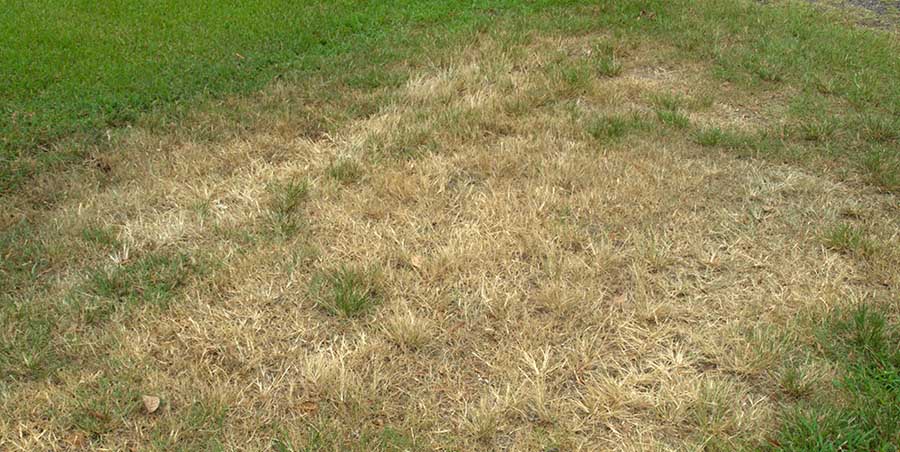
- Grass seed must be kept consistently damp to germinate. If you’re trying to seed your lawn to make it more lush, keep in mind that the grass seed needs to be kept wet to germinate—if it dries out, the seed will die. That means that spots with grass seed should be watered more often than the lawn is usually watered to make sure the seeds don’t have a chance to dry.
- Do not forget to winterize your sprinkler systems. If you have in-ground sprinkler systems or free-standing faucets that are attached to hoses and sprinkler systems, these faucets and sprinkler heads need to be insulated for sub-freezing temperatures to prevent busted pipes and other cold-related damage.
I wrote a comprehensive article about how to winterize your irrigation system, check it out here.
Watering a lawn is not complicated, but the above hints can help you get the most out of your watering equipment. Knowing how to water the yard properly means the difference between a lush, green, vibrant yard and one that is scraggly and half-dead.
Soaker Hoses Beat Sprinklers When It Comes to Lawn Maintenance
Just because soaker hoses save an immense amount of water, they beat out sprinkler systems when it comes to keeping your lawn well-watered. If you use a sprinkler system multiple times a week, it results in thousands of gallons of wasted water. A soaker hose, in comparison, will use less than a hundred in the same amount of time.
While sprinkler systems may be advantageous in some situations, there is no beating soaker hoses for efficiency when it comes to watering the lawn.

